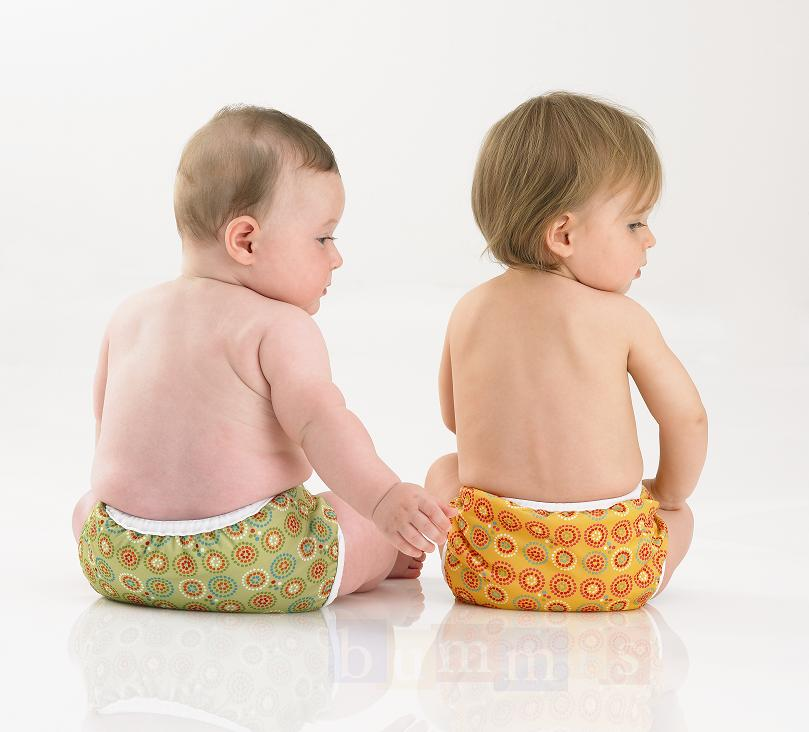Special Considerations: Newborns
Posted on July 26, 2011
 Whether you decide to cloth diaper your newborn while you're still at the hospital or whether you start in the first few days, there are few things to keep in mind that will make those early weeks a breeze.
Whether you decide to cloth diaper your newborn while you're still at the hospital or whether you start in the first few days, there are few things to keep in mind that will make those early weeks a breeze.
Containment
Since young infants take in only liquid and their little tummies and colons are still developing, their stools tends to be quite runny and are part of every diaper change. Also, since their bladders are quite small at this stage of life, their amount of pee is not copious. Thus, containment is more important for this stage of diapering than absorbancy is. For containment success, choose well-fitting diapers and covers with good leg and back elastics, such as prefolds inside a Bummis Super Brite or the small AMP Duo pocket diaper.Umbilical Stump
Until the umbilical stump falls off (somewhere between 4-16 days), it's important to make sure nothing rubs against it to aggravate it and that there's enough air flow to keep it dry. Covers and diapers created with newborns in mind are designed with a notch to fit around the umbilical stump - perennial parent favorites are the Kissaluvs Size O fitted diaper and the Bummis Super Brite cover. The all-new GroVia Newborn AIO is shaping up to be a fave as well.The Joys of Meconium
Meconium is the blackish-green tar-like substance that your baby cleans out of his or her system in the first day or two of life. It is sticky and stains diapers easily, so we definitely recommend investing in a few liners with which to line your diapers. There are flushable options, natural fibre options, and fleece options - so every parent's diapering objectives can easily be met. Liners are also great through the first few weeks as the baby's stools go through various phases (not to mention colors and consistencies!) These make clean-up easy and minimize staining. And of course, if you do get any stains on your diapers, setting them in the sunshine for a few hours will do wonders for whitening your diapers and erasing stains.Skinny Legs
Babies come in all shapes and sizes - some have lovely rolls of baby fat while others tend to be long and skinny. What to do to keep the diapers fitting if you've got a lanky child? You can either have a few teeny-tiny diapers on hand, such as the extra-small Fuzzi Bunz pocket diaper or the TiniFit All-in-One (one of our all-time best-selling diapers), or have on hand a few extra newborn covers. The overlapping velcro tabs and extra gussets on the Bummis Super Brite newborn cover do a superb job of adjusting to your baby's smaller size.Fit
One issue that often frustrates new parents is that the small diapers they so carefully researched and purchased before their baby was born don't seem to fit. And it's often true - there is something about newborns that makes an 8-pound newborn fit differently in a diaper than an 8-pound, 6-week-old infant. Despite the intent of various diaper manufacturers to have larger diapers "fit from birth," more and more leaders in the cloth diaper industry, New & Green included, are recommending that parents set aside their one-size and sized diapers until about 6-8 weeks of age and use newborn-sized diapers at birth. There are some great options that will allow you to keep using those newborn prefolds long past the newborn stage, and avoiding all that extra bulk definitely makes the extra investment worth it. And as always, if you don't want to purchase extra diapers, you can always rent them. Easy! But now, we want to hear from you - how did you successfully get through those early days? What made the difference in your family?Photo Credit - SCA Svenska Cellulosa Aktiebolaget
Previous: Eucalan No Rinse Wool Wash





